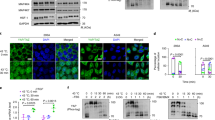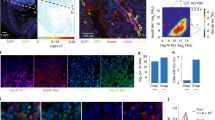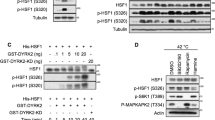Abstract
The heat shock response is an evolutionarily conserved response to heat and other stresses that promotes the maintenance of key metabolic functions and cell survival. We report that exposure of human prostate (DU-145) and breast (MCF-7) cancer cells to heat (42°C) caused a rapid disappearance of the breast cancer susceptibility gene-1 (BRCA1) protein, starting at ≈1 h after the onset of heating and slightly lagging behind the increase in heat shock protein 70 (HSP70) levels. The heat-induced loss of BRCA1 occurred at the protein level, since: (1) BRCA1 mRNA expression was unaffected; and (2) the BRCA1 protein loss was also observed in DU-145 cells that expressed exogenous wild-type BRCA1 (wtBRCA1). In addition to heat regulation of BRCA1 protein levels, we also found that BRCA1 could modulate the heat shock response. Thus, wtBRCA1 overexpressing DU-145 cell clones showed significantly decreased sensitivity to heat-induced cytotoxicity; and Brca1 mutant mouse embryo fibroblasts showed increased sensitivity to heat. The DU-145 wtBRCA1 clones also showed increased expression of the small heat shock protein HSP27; and reporter assays revealed that wtBRCA1 stimulated a two to four-fold increase in HSP27 promoter activity, consistent with its ability to upregulate HSP27 mRNA and protein levels. In studies using epitope-tagged truncated BRCA1 proteins, the ability to stimulate the HSP27 promoter and to mediate heat-induced degradation required the amino-terminus but not the carboxyl-terminus of BRCA1. Although the heat-induced loss of BRCA1 appeared to be due to protein degradation, various protein metabolic agents (or combinations) failed to block this event, including: MG132 (a 26S proteasomal inhibitor), N-acetyl-leucyl-leucyl-norleucinal (a calpain inhibitor), z-VAD-fmk (a pan-caspase inhibitor), and ammonium chloride and chloroquine (which stabilize lysosomes). These findings suggest that in addition to its other functions, BRCA1 may participate in mammalian heat shock response pathways.
This is a preview of subscription content, access via your institution
Access options
Subscribe to this journal
Receive 50 print issues and online access
$259.00 per year
only $5.18 per issue
Buy this article
- Purchase on Springer Link
- Instant access to full article PDF
Prices may be subject to local taxes which are calculated during checkout











Similar content being viewed by others
References
Alley MC, Scudieco DA, Monks A, Hursey ML, Czerwinski MJ, Fine DL, Abbott BJ, Mayo JG, Shoemaker RH, Boyd MR . (1988). Cancer Res., 48, 589–601.
Andres JL, Fan S, Turkel GJ, Wang J-A, Twu N-F, Yuan R-Q, Lamszus K, Goldberg ID, Rosen EM . (1998). Oncogene, 16, 2229–2241.
Aoyama A, Frohli E, Schafer R, Klemenz R . (1993). Mol. Cell. Biol., 13, 1824–1835.
Bates PJ, Coetzee GA, Van der Westhuyzen DR . (1982). Biochim. Biophys. Acta., 719, 377–387.
Benndorf R, Hayess K, Ryazantsev S, Wieske M, Behlke J, Lutsch G . (1994). J. Biol. Chem., 269, 20780–20784.
Blagosklonny MV, An WG, Melillo G, Nguyen P, Trepel JB, Neckers LM . (1999). Oncogene, 18, 6460–6468.
Bossy-Wetzel E ., Newmeyer DD, Green DR . (1998). EMBO J., 17, 37–49.
Bruey JM, Paul C, Frmentin A, Hilpert S, Arrigo AP, Solary E, Garrido C . (2000). Oncogene, 19, 4855–4863.
Brzovic PS, Meza J, King MC, Klevit RE . (1998). J. Biol. Chem., 273, 7795–7799.
Bubendorf L, Kolmer M, Kononen J, Koivisto P, Mousses S, Chen Y, Mahlamaki E, Schraml P, Moch H, Willi N, Elkahloun AG, Pretlow TG, Gasser TC, Mihatsch MJ, Sauter G, Kallioniemi OP . (1999). J. Natl. Cancer Inst., 91, 1758–1764.
Chen Y, Farmer AA, Chen C-F, Jones DC, Chen P-L, Lee W-H . (1996). Cancer Res., 56, 3168–3172.
Cornford PA, Dodson AR, Parsons KF, Desmond AD, Woolfenden A, Fordham M, Neoptolemos JP, Ke Y, Foster CS . (2000). Cancer Res., 60, 7099–7105.
Creagh EM, Sheehan D, Cotter TG . (2000). Leukemia, 14, 1161–1173.
Fan S, Twu N-F, Wang J-A, Yuan R-Q, Andres J, Goldberg ID, Rosen EM . (1998a). Int. J. Cancer, 77, 600–609.
Fan S, Wang J-A, Yuan R-Q, Ma YX, Meng Q, Erdos MR, Brody LC, Goldberg ID, Rosen EM . (1998b). Oncogene, 16, 3069–3083.
Fan S, Wang J-A, Meng Q, Yuan R-Q, Ma YX, Erdos MR, Pestell RG, Yuan F, Auborn KJ, Goldberg ID, Rosen EM . (1999a). Science, 284, 1354–1356.
Fan S, Wang J-A, Yuan R-Q, Goldberg ID, Rosen EM . (1999b). Int. J. Radiat. Biol., 75, 301–316.
Fan S, Wang J-A, Yuan R-Q, Goldberg ID, Rosen EM . (1999c). Prostate, 40, 37–49.
Fan S, Wang J-A, Ma YX, Wang C, Yuan R-Q, Meng Q, Erdos MR, Goldberg ID, Webb P, Kushner PJ, Pestell RG, Rosen EM . (2001a). Oncogene, 20, 77–87.
Fan S, Yuan R-Q, Ma Y-X, Xiong J, Meng Q, Erdos M, Goldberg ID, Rosen EM . (2001b). Oncogene, 20, 8215–8235.
Fang G, Yu H, Kirschner MW . (1998). Mol. Cell, 2, 163–171.
Ford D, Easton DF, Bishop DT, Narod SA, Goldgar DE . (1994). Lancet, 343, 692–695.
Forsythe HL, Jarvis JL, Turner JW, Elmore LW, Holt SE . (2001). J. Biol. Chem., 276, 15 571–15 574.
Fung TK, Q7Siu WY, Yam CH, Lau A, Poon RY . (2002). J. Biol. Chem., 277, 35140–35149.
Gao B, Shen X, Kunos G, Meng Q, Goldberg ID, Rosen EM, Fan S . (2001). FEBS Lett., 488, 179–184.
Garrido C, Bruey JM, Fromentin A, Hammann A, Arrigo AP, Solary E . (1999). FASEB J., 13, 2061–2070.
Gavrieli Y, Sherman Y, Ben-Sasson SA . (1992). J. Cell Biol., 119, 493–501.
Gowen LC, Avrutskaya AV, Latour AM, Koller BH, Leadon SA . (1998). Science, 281, 1009–1012.
Guenal I, Sidoti-de Fraisse C, Gaumer S, Mignotte B . (1997). Oncogene, 15, 347–360.
Hakem R, de la Pomba JL, Sirard C, Mo R, Woo M, Hakem A, Wakeham A, Potter J, Reitmair A, Billia F, Firpo E, Hui CC, Roberts J, Rossant J, Mak TW . (1996). Cell, 85, 1009–1023.
Herrmann M, Lorenz H-M, Voll R, Grunke M, Woith W, Kalden JR . (1994). Nucl. Acids Res., 22, 5506–5507.
Horman S, Galand P, Mosselmans R, Legros N, Leclercq G, Mairesse N . (1999). Int. J. Cancer, 82, 574–582.
Huber LJ, Yang TW, Sarkisian CJ, Master SR, Deng CX, Chodosh LA . (2001). Mol. Cell. Biol., 21, 4005–4015.
Inoue S, Bar-Nun S, Roitelman J, Simoni RD . (1991). J. Biol. Chem., 266, 13 311–13 317.
Jaattela M, Wissing D, Kokholm K, Kallunki T, Egeblad M . (1998). EMBO J., 17, 6124–6134.
Jensen DE, Proctor M, Marquis ST, Gardner HP, Ha SI, Chodosh LA, Ishov AM, Tommerup M, Vissing H, Sekido Y, Minna J, Borodovsky A, Schultz DC, Wilkinson KD, Maul GG, Barlev N, Berger SL, Prendergast GC, Rauscher Jr FJ . (1998). Oncogene, 16, 1097–1121.
Jin S, Zhao H, Fan F, Blanck P, Fan W, Colchagie AB, Fornace Jr AJ, Zhan Q . (2000). Oncogene, 19, 4050–4057.
Jolly C, Morimoto RI . (2000). J. Natl. Cancer Inst., 92, 1564–1572.
Kamradt MC, Chen F, Cryns VL . (2001). J. Biol. Chem., 276, 16059–16063.
Lee DH, Goldberg AL . (1996). J. Biol. Chem., 271, 27280–27284.
Lee JS, Collins KM, Brown AL, Lee CH, Chung JH . (2000). Nature, 404, 201–204.
Mairesse N, Horman S, Mosselmans R, Galand P . (1996). Cell Biol. Int., 20, 205–212.
Miki Y, Swensen J, Shattuck-Eidens D, Futreal PA, Harshman K, Tavtigian S, Liu Q, Cichran C, Bennett LM, Ding W et al (1994). Science 266, 66–71.
Miron T, Vancompernolle K, Vanderkerckhove J, Wilchek M, Geiger B . (1991). J. Cell Biol., 114, 255–261.
Moynahan ME, Chiu JW, Koller BH, Jasin M . (1999). Mol. Cell, 4, 511–518.
Nakamoto H, Suzuki N, Roy SK . (2000). FEBS Lett., 483, 169–174.
Newton EM, Knauf U, Green M, Kingston RE . (1996). Mol. Cell. Biol., 16, 839–846.
Nylandsted J, Brand K, Jaattela M . (2000a). Ann. N.Y. Acad. Sci., 926, 122–125.
Nylandsted J, Rohde M, Brand K, Bastholm L, Elling F, Jaattela M . (2000b). Proc. Natl. Acad. Sci. U.S.A., 97, 7871–7876.
Ouchi T, Lee SW, Ouchi M, Aaronson SA, Horvath CM . (2000). Proc. Natl. Acad. Sci. USA, 97, 5208–5213.
Pandey P, Saleh A, Nakazawa A, Kumar S, Srinivasula SM, Kumar V, Weichselbaum R, Nalin C, Alnemri ES, Kufe D, Kharbanda S . (2000). EMBO J., 19, 4310–4322.
Payne J, Nair MP, Ambrus JL, Chadha KC . (2000). Int. J. Hyperthermia, 16, 492–507.
Pfleger CM, Kirschner MW . (2000). Genes Dev., 14, 655–665.
Pirkkala L, Nykanen P, Sistonen L . (2001). FASEB J., 15, 1118–1131.
Oesterreich S, Lee AV, Sullivan TM, Samuel SK, Davie JR, Fuqua SA . (1997). J. Cell. Biochem., 67, 275–286.
Poole B, Ohkuma S, Warburton MJ . (1997). Acta Biol. Med. Ger., 36, 1777–1788.
Rogers S, Wells R, Rechsteiner M . (1986). Science, 234, 364–368.
Rubin SJ, Hallahan DE, Ashman CR, Brachman DG, Beckett MA, Virudachalam S, Yandell DW, Weichselbaum RR . (1991). J. Surg. Oncol., 46, 31–36.
Ruffner H, Joazeiro CA, Hemmati D, Hunter T, Verma IM . (2001). Proc. Natl. Acad. Sci. USA, 98, 5134–5139.
Saleh A, Srinivasula SM, Balkir L, Robbins PD, Alnemri ES . (2000). Nat. Cell Biol. 2, 476–483.
Sato S, Fujita N, Tsuruo T . (2000). Proc. Natl. Acad. Sci. USA, 97, 10832–10837.
Scully R, Anderson SF, Chao DM, Wei W, Ye L, Young RA, Livingston DM, Parvin JD . (1997a). Proc. Natl. Acad. Sci. USA, 94, 5605–5610.
Scully R, Chen J, Ochs RL, Keegan K, Hoekstra M, Feunteun J, Livingston DM . (1997b). Cell, 90, 425–435.
Shao N, Chai YL, Shyam E, Reddy P, Rao VM . (1996). Oncogene, 13, 1–7.
Somasundaram K, Zhang H, Zeng Y-X, Houvras Y, Peng Y, Zhang H, Wu GS, Licht JD, Weber BL, El-Deiry WS . (1997). Nature, 389, 187–190.
Streuwing JP, Hartge P, Wacholder S, Baker SM, Berlin M, McAdams M, Timmerman MM, Brody LC, Tucker MA . (1997). N. Engl. J. Med., 336, 1401–1408.
Thomas JE, Smith M, Tonkinson JL, Rubinfeld B, Polakis P . (1997). Cell Growth Differ., 8, 801–809.
Tirkkonen M, Johannson O, Agnarsson BA, Olsson H, Ingvarsson S, Karbu R, Tanner M, Isola J, Barkardottir RB, Borg A, Kallioniemi OP . (1997). Cancer Res., 57, 1222–1227.
Trautinger F, Kokesch C, Herbacek I, Knobler RM, Kindas-Mugge I . (1997). J. Photochem. Photobiol. B., 39, 90–95.
Wang Q, Zhang H, Kajino K, Greene MI . (1998). Oncogene, 17, 1939–1948.
Waterhouse NJ, Goldstein JC, Van Ahsen O, Schuler M, Newmeyer DD, Green DR . (2001). J. Cell Biol., 153, 319–328.
Wosikowski K, Regis JT, Robey RW, Alvarez M, Buters JT, Gudas JM, Bates SE . (1995). Cell Growth Differ., 6, 1395–1403.
Yarden RI, Brody LC . (1999) Proc. Natl. Acad. Sci. USA, 96, 4983–4988.
Yu X, Wu LC, Bowcock AM, Aronheim A, Baer R . (1998). J. Biol. Chem., 273, 25388–25392.
Zhang H, Somasundaram K, Peng Y, Tian H, Zhang H, Bi D, Weber BL, El-Deiry WS . (1998). Oncogene, 16, 1713–1721.
Zhu H, Fearnhead HO, Cohen GM . (1995). FEBS Lett., 374, 303–308.
Acknowledgements
This research was supported, in part, by research grants from the USPHS (R01-ES09169, RO1-CA80000, and R01-CA82599), the Susan G Komen Breast Cancer Foundation (BASIC-003255), and the US Army Breast Cancer Research Program (DAMD17-99-1-9254).
Author information
Authors and Affiliations
Corresponding author
Rights and permissions
About this article
Cite this article
Xian Ma, Y., Fan, S., Xiong, J. et al. Role of BRCA1 in heat shock response. Oncogene 22, 10–27 (2003). https://doi.org/10.1038/sj.onc.1206061
Received:
Revised:
Accepted:
Published:
Issue Date:
DOI: https://doi.org/10.1038/sj.onc.1206061
Keywords
This article is cited by
-
Effects of hyperthermia on DNA repair pathways: one treatment to inhibit them all
Radiation Oncology (2015)
-
Mechanisms of heat shock response in mammals
Cellular and Molecular Life Sciences (2013)
-
Glucose-regulated protein 78 as a novel effector of BRCA1 for inhibiting stress-induced apoptosis
Oncogene (2008)



